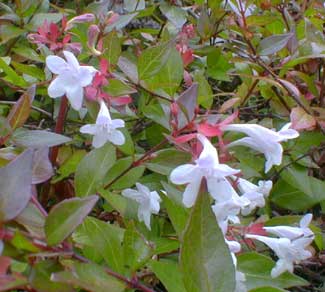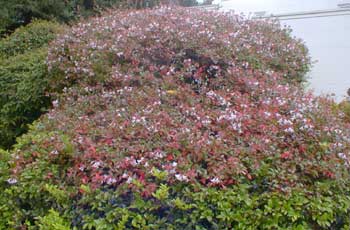
Glossy Abelia
"O world, I cannot hold thee close enough!
Thy winds, thy wide gray skies!
Thy mists, that roll & rise!
Thy woods, this autumn day, that ache & sag
And all but cry with color!"
-Edna St Vincent Millay
(1892-1950)
(1892-1950)
Abelia grandiflora, the Glossy or Smooth Abelia, is a hybrid of the Chinese shrubs A. chinensis & A. uniflora. It has has two-inch long one-inch wide pointed lustrous leaves.
The dark green foliage is very compact, so that this abelia can be hedged square or into perfect mounds or even used for topiaries. The second photo shows a shaped abelia high on a gardened hillside, hedged into an oval, with its lower limbs turned into part of the shaping of a different shrub lower on the hill, causing an evergreen vaccinium to look like it has abelia blooms on its top.
The specimen shown here is growing at the end of the block as part of a densely planted & well-tended rather formal house-front garden that consists mainly of evergreen shrubs that are very carefully shaped, much tidier than they'd be if they were left half-wild in my own gardens.
 Left unpruned it can reach as much as eight feet wide or wider, & six feet high, with an arching appearance not quite as dense as when it is hedged each year.
Left unpruned it can reach as much as eight feet wide or wider, & six feet high, with an arching appearance not quite as dense as when it is hedged each year.It blooms best on new wood, so even if it is not hedged it should be given a good pruning every couple of years. For an un-hedged specimen, it's best to remove the older branches to the base, in order to preserve the arching stems.
It likes soil to the acidic side & prefers full sun though it will bloom well in bright shade too. In deeper shade it would get lanky & stop blooming. Here on Puget Sound, winters are so mild that there are usually a few flowers on it just about year-round (May to January), but it is most serioiusly floriferous July through October or so. This long period of flowering is wonderful.
The trumpet flowers are liked by hummingbirds & butterflies. They make nice cuttings for bouquets. Although often listed as mildly fragrant, the blooms seem scentless to me.
Some but not all of its leaves take on a burnished or brassy hue in winter with some very coppery red leaves. It's pretty strongly evergreen here in Zone 8, but in even slightly cooler climates it will drop at least a third of its leaves in winter, becoming deciduous in zone 6, while in zone 5 it may behave as a die-back perennial & remain smaller, rather than becoming the big shrub it can be in the Pacific Northwest. So while it is suited to zones 5 through 9, its behavior is dramatically different from zone to zone.
Smooth or Glossy Abelia was once the standard abelia in the nursery industry & is what one usually sees in older gardens, but for some while now, it has been increasingly displaced by the larger-bloomed 'Edward Goucher.' In our own yard we have a huge specimen of 'Edward Goucher' which in comparison to the Smooth Abelia has slightly larger leaves crinkled rather than smooth, larger pinker flowers, thicker stems, & a looser habit at maturity.
The regular Smooth Abelia has such faded pink blush that the flowers are essentially white. Its shiny leaves have none of the bumpliness of 'Edward Goucher.'
Abelias are for the most part pest-free & exceedingly hardy. They can become chloratic with yellowing leaves in poor soil, especially during cold weather, but a spring or autumn topcoating of composted manure would quickly remedy this possibility. It's moderately drought-hardy when established.